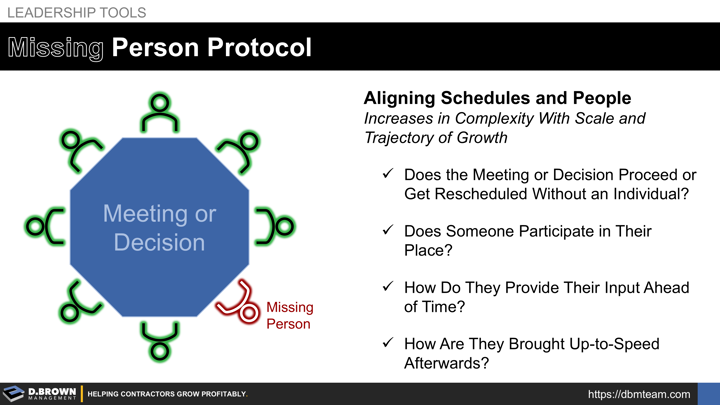When a construction business is starting up, most decisions can come down to one person. Information flow and meetings will never get easier than this as a contractor scales. As you get into the fourth stage of growth and beyond, getting all the required parties involved to make good decisions, align, then execute becomes increasingly more difficult.
The challenge of aligning people is a product of:
- Organizational size (headcount)
- Trajectory of growth
- Average tenure of the people on the team working together (turnover & growth trajectory)
- Average experience level they have in the roles they are in
This is especially true if your management structure is at the "Hollow" phase of development.
Meetings are incredibly valuable but also incredibly difficult because they require synchronizing on time and location. Virtual meetings and conference calls can help with the location synchronization if managed correctly but you still have the challenge of the time synchronization.
It is incredibly easy for people in roles like Project Manager to spend a significant amount of their time being pulled into meetings as demanded by their customers, direct managers, and peer managers then not have enough time to get the tasks done that create the positive outcomes on projects such as the Short-Interval-Planning (SIP) workflow.
The first thing to do is look at your meeting schedule from the perspective of all participants. If it's an ad-hoc meeting, that means just finding time when all can participate effectively. For routine meetings, look at the weekly and monthly schedules of all participants, knowing that a role like PM may be pulled into 3-5 customer-driven meetings each week along with internal meeting workloads for project reviews, kick-offs, close-outs, and training.
Once you've settled on the most optimal meeting rhythm for your current team and business dynamics, start looking at what you do if someone is missing from the meeting and develop a simple standard.
- Does the meeting and/or decision proceed without the individual or get rescheduled?
- Does someone participate on their behalf including delegation of decision rights, if applicable?
- Does the missing person provide their input ahead of time? If so, how?
- How is the missing person brought up to speed afterwards?
Keep in mind that your meetings must be designed to be effective operationally and developmentally. During growth it is far too easy to get into an "Efficiency Mindset," focusing solely on the decision and delivery while shortcutting the learning process for others as they see how decisions are made. This can create a short-term boost to productivity but at a huge long-term cost to scalability, resiliency, and succession readiness.

